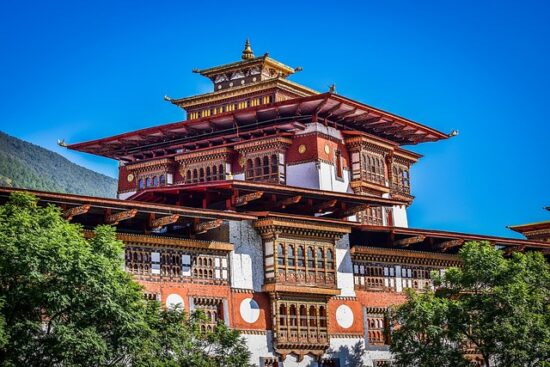It is as exotic as it can be. Bhutan is found in the eastern part of the Himalayas and is considered to be the last culturally and environmentally unspoiled kingdom. The reason precisely why it is dubbed as “The Last Shangrila”. The capital and largest city is Thimpu, which is also where the seat of government is, and the center of religion as well as economic activity. The city has a character of its own brought about by its most culturally unique and stunning architectural structures and sites. This well-preserved city has much to offer besides its marvelous natural landscapes.

Trashichhoedzong
Perhaps the most iconic structure in the country, Trashichhoedzong, which means “fortress of the glorious religion”, is actually one that not only dominates Thimpu, but also assumes numerous functions. It is the main secretariat building that holds the government’s main departments and ministries, the National assembly Hall, and the King of Bhutan’s Throne Room. In the summer, this dzong is the home of the religious chief Je Khempo.
Originally built in the 17th century and renovated in the early 1960s, the enormous dzong houses precious items within. You will find a statue of Buddha as high as a two-storey building, as well as paintings depicting the 12 stages of Buddha-hood on the walls. Aside from these, the two columns Kanju and Tenju can also be seen here. These two are said to be symbols of the ascendancy of Religion and Politics in the kingdom.
National Memorial Chorten
Another unique structure is the prominent National Memorial Chorten. This stupa, which is predominantly white with spires of gold, was erected in 1974 in honor of the father of modern Bhutan, the third king of the country, His Majesty Jiqme Dorji Wangchuck. Inside you will find mandalas, paintings, statues and and shrines dedicated to the king.
The exterior as well as the interior of the stupa should should be studied intently as this place allows you to peek into the kingdom’s Buddhist philosophy. Bhutan is the only country in the world that practices Vjarayana Buddhism.
The National Textile Museum
Although not a building as uniquely awe-inspiring as the two previously mentioned, the National Textile Museum allows you to have a deep sense of the distinct culture and arts of Bhutan through its exhibitions. It has a total of six sections with the following themes- the warp pattern weaves, weft pattern weaves, the role of textiles in religion, achievements in textile arts, textiles from indigenous fibers and the royal collection.
You will also see the crowns of the kings of Bhutan including the first version of the royal crown, the dresses and accessories worn by the members of the royal family. Your short immersion in this museum will start with a short documentary film of the history of Bhutanese textile.
Other sites you might enjoy around Thimpu would be the Weekend Market from Fridays thru Sundays, the Folk Heritage Museum, the Simtokha Dzong, the monasteries, the Traditional Painting School and the Traditional Medicine Institute. Definitely worth a visit, Thimpu is a destination you cannot compare with any other.
